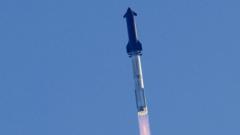The United States has temporarily grounded SpaceX's formidable Starship rocket following a catastrophic explosion that broke out during its latest test flight. Launched from Texas, the rocket's upper stage exploded and fell apart over the Caribbean on Thursday. The incident compelled nearby airline flights to make adjustments to their routes in order to evade the raining debris. No injuries were reported, but the Federal Aviation Administration (FAA) is actively collaborating with SpaceX and other officials to investigate any potential damage inflicted upon public properties, notably in the Turks and Caicos Islands.
In compliance with the findings of a "mishap" investigation ordered by the FAA, SpaceX's path to return Starship to the skies will hinge upon the outcome of this inquiry. The FAA has established a "debris response area," affecting the operations of various aircraft that were diverted outside the debris field, including some that ran low on fuel.
Starship, which is hailed as the world's most powerful rocket, is pivotal to Elon Musk's vision of establishing a human presence on Mars. Despite Starship's uncrewed launch being its seventh test flight, it marked the debut of a taller, upgraded variant of the rocket—an important evolutionary step in its design, according to SpaceX.
On Thursday, the Starship upper stage separated from its Super Heavy booster approximately four minutes post-launch and ascended as anticipated. However, shortly thereafter, communications were lost, and the upper stage experienced what SpaceX termed as "rapid unscheduled disassembly." The Super Heavy booster successfully returned to its launchpad, sparking celebrations at the control center.
Musk speculated that the explosive failure may have been traced to an "oxygen/fuel leak in the cavity above the ship engine firewall," but stressed that these preliminary observations do not imply a major delay in upcoming launches.
The Starship system, which stands at 123 meters (403 feet) tall, aims to be fully reusable. NASA is eyeing a modified iteration of the Starship to serve as a human lunar lander amid its Artemis missions intended to revive lunar exploration. Looking farther ahead, Musk envisions using Starship for lengthy trips to Mars, spanning around nine months for each journey.
Coincidentally, this test flight coincided with the inaugural flight of Amazon's Blue Origin New Glenn rocket, reflecting a burgeoning rivalry between Bezos and Musk in the space market. The race for supremacy in space travel continues, with both billionaires vying for dominance.
In compliance with the findings of a "mishap" investigation ordered by the FAA, SpaceX's path to return Starship to the skies will hinge upon the outcome of this inquiry. The FAA has established a "debris response area," affecting the operations of various aircraft that were diverted outside the debris field, including some that ran low on fuel.
Starship, which is hailed as the world's most powerful rocket, is pivotal to Elon Musk's vision of establishing a human presence on Mars. Despite Starship's uncrewed launch being its seventh test flight, it marked the debut of a taller, upgraded variant of the rocket—an important evolutionary step in its design, according to SpaceX.
On Thursday, the Starship upper stage separated from its Super Heavy booster approximately four minutes post-launch and ascended as anticipated. However, shortly thereafter, communications were lost, and the upper stage experienced what SpaceX termed as "rapid unscheduled disassembly." The Super Heavy booster successfully returned to its launchpad, sparking celebrations at the control center.
Musk speculated that the explosive failure may have been traced to an "oxygen/fuel leak in the cavity above the ship engine firewall," but stressed that these preliminary observations do not imply a major delay in upcoming launches.
The Starship system, which stands at 123 meters (403 feet) tall, aims to be fully reusable. NASA is eyeing a modified iteration of the Starship to serve as a human lunar lander amid its Artemis missions intended to revive lunar exploration. Looking farther ahead, Musk envisions using Starship for lengthy trips to Mars, spanning around nine months for each journey.
Coincidentally, this test flight coincided with the inaugural flight of Amazon's Blue Origin New Glenn rocket, reflecting a burgeoning rivalry between Bezos and Musk in the space market. The race for supremacy in space travel continues, with both billionaires vying for dominance.



















